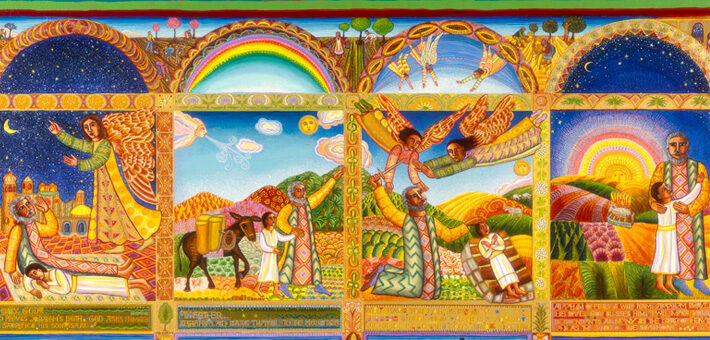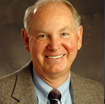Commentary on Matthew 24:36-44
Be honest! What are your first thoughts as you anticipate the first Sunday of Advent? For me, both as preacher and as worshiper in the pew, the church year and the gospel readings always seem somehow out of synch with other life rhythms.
The student only half-humorously jokes that it is only the second day of class and she is already two weeks behind. We have just cleared the Thanksgiving table, we already feel ourselves months behind on the Christmas shopping list, we’ve long been planning for the special programs and festivities that will lead up to that day, and yet now we’re invited to think about Advent and beginnings. If Advent speaks of “coming,” instead of the coming of Christmas-in long-standing tradition, this first Sunday of Advent invites reflection on the eschatological theme of Christ’s second coming. These thoughts often call forth uncomfortable associations of end times and judgment and encourage the preacher to skirt around a subject not on most people’s popularity list. If the beginning of a new church year invites fresh perspectives on physical or spiritual life rhythms, then we will be challenged by negative impressions of the same-old, same-old of our world in which nothing seems to change.
Since the reading from Matthew for this Sunday plunges into the middle of the narrative of this year’s gospel, it will be time well-spent in preparation for this new year of preaching to read through the whole of the gospel, preferably in one sitting. Such reading will hear again the amazing promises which frame this gospel and the life of discipleship: “And they shall name him Emmanuel, which means “God is with us.” (1:23) and “Remember, I am with you always, to the end of the age.” (28:20) It will follow as the narrative presents Jesus as the Messiah of God (1-4:17), powerful in his ministry of word and deed (4:18-16:20), and culminating in his suffering, death, and resurrection. The hearer will be summoned again to Matthew’s particular themes of discipleship in Jesus so-called five “speeches:” the Sermon on the Mount (5-7); the teaching on discipleship (10-12; “Come to me, all you that are weary.and I will give you rest” 11:28); on the transforming power of the new disciple community (18-19; “For where two or three are gathered.I am there” 18:20); and on living now as disciples in the sure and certain expectation of Jesus’ coming again as Messiah (24-25; “As you did it to one of the lest of these…you did it to me” 25:40).
Reading in this wider context is especially important, since it is precisely in this last section and its themes that the lesson for Advent 1 is located. There are a number of potentially interesting details in this lesson that could be misleading sidetracks, but two simple, yet dominant, themes stand at its heart balancing and playing off one another in talk “about that day and hour” (24:36).
The first theme is this lesson’s sure and certain promise that God’s future and our future belong to this Messiah, the Son of Man. The “that day” of the text refers back to the promise of the Son of Man’s coming when he will “gather his elect from the four winds” (24:31). And then three times in this lesson, at beginning, middle, and end, the promise of his coming is a refrain that structures and underscores the surety of God’s promise in this Messiah: “The Son of Man is coming” (24:37, 39, 44).
The second theme is that of “knowing” – actually of “not knowing.” Five times it drives its point: “no one knows, not even the Son” (36); “they knew nothing” (39); “you do not know” (42); if the owner had known” (43); and “at an unexpected hour” (44).
Focusing on these two themes of promise and not-knowing, one will escape being sidetracked by verses 40-41 and talk about the Rapture that has captured the imaginations of many modern readers. These verses have only one purpose. Like the story of Noah, they simply illustrate our lack of knowledge about how and when these things will take place.
It’s this theme of not knowing that is surely the key for the preacher. The danger for every Christian community – it must have been for Matthew’s own – is that the important questions of When?, How?, Why? How can I know? (see 24:3) do not seem to get answers. The danger is then that not knowing turns either into not believing and despair or into wild speculation and fears. The beginning of the new year and the sounding of the Advent trumpet with its themes of “coming” may then only fall on ears and hearts that are numbed by the “same-old, same-old.” “Well here we go again; so what’s new?” “Has anything really changed?” we ask. The problem for us is the sameness, the routine of it all – whether good or bad.
How do you prepare for a promise? Promises by their very nature always come as a surprise. This gospel lesson balances the surety of the promise of the coming of the Son of Man -the promise of God’s nearness to our world and our lives-with the not knowing, the mystery, the whens and whys that mark our lives in the meantime.
Such promises call use to watch-to “be awake” (42) -not just for what is to come, but to continuous preparedness for what is already taking place in our midst. The danger is that we will be lulled to sleep in the seeming sameness or disappointing news of the world around us. When this happens, our failure is in not knowing the significance of this day-that each day is lived in the promise of the Lord’s nearness. The Son of Man is coming and you must be ready.
The task for the preacher is to help us see the mystery and the promise of the extraordinary presence of God in the ordinary routines of life, or even in those disastrous events that make God’s presence so difficult to envision. Enable our imaginations. It takes imagination shaped by God’s promises to see the poetry of God’s working in the reality of today’s same-old.
It will help to observe Matthew’s own way of doing this. In the lessons that follow it is as if Matthew imagines in a series of parables unique to his gospel what this watchfulness would look like: a servant who takes faithful care of the master’s household (24:45-51); ten maidens, five of whom keep their lamps trimmed (25:1-13); stewards who care responsibly for what is entrusted to them (25:14-30); or ones who “not-knowing” still go about unconsciously caring for those in need (25:31-46).
In the same way the preacher will help us to hear and embody once again the excitement, the expectation, the surety of God’s promise to be near us as we live in faithful discipleship while waiting the coming of Christ our Lord.


December 2, 2007